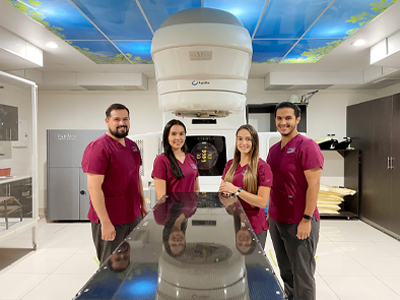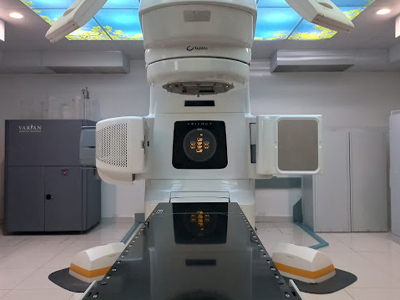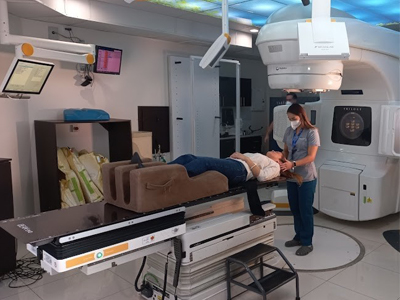Radioterapia con Imágenes Guiadas
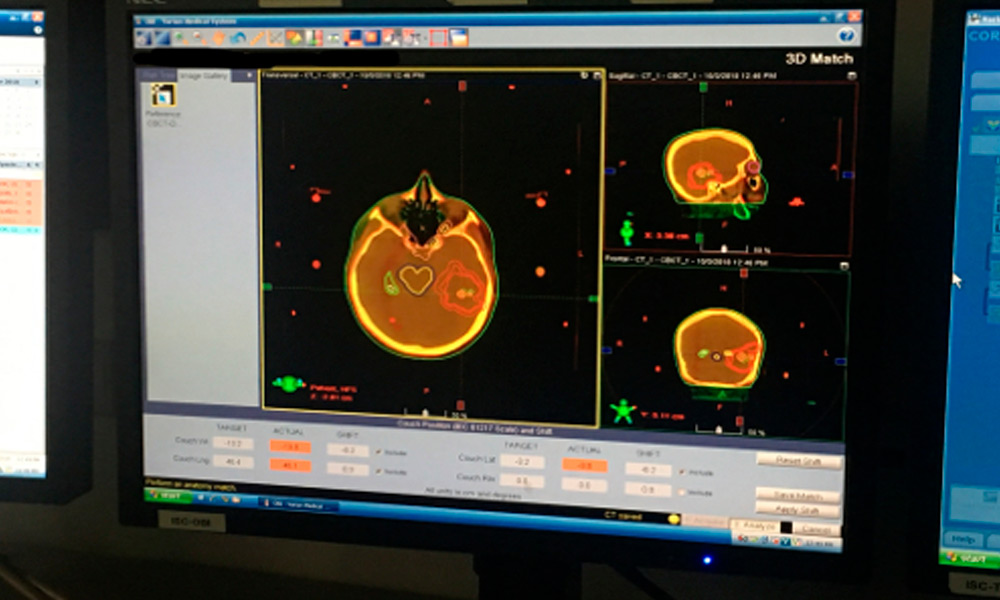
Permite
- Confirmar y seguir el movimiento del tumor en el momento del tratamiento.
- Minimizar el riesgo de efectos secundarios.
- Dosis más altas de radiación – en última instancia conduce a mayores tasas de curación.
- Corregir cambios en la anatomía del paciente: Subir o bajar de peso a lo largo de los 25 a 35 días.
- Permite corregir posicionamiento diario, ya que los tumores se pueden desplazar varios centímetros cuando los pacientes respiran durante el tratamiento.
¿Quiénes participan en este procedimiento y quien maneja el equipo?
La entrega de radioterapia requiere un equipo de tratamiento, que incluye un oncólogo radioterapeuta, físico médico terapeuta, dosimetrista e imagenólogos. El oncólogo radioterapeuta es un médico que evalúa al paciente y determina la terapia o combinación de terapias apropiadas y el tipo de IGRT. El médico determina cuál área se debe tratar y la dosificación a entregar. Conjuntamente con el físico médico terapeuta y el dosimetrista, el médico determina cuáles técnicas se deben usar para entregar la dosificación prescrita. El físico y el dosimetrista entonces hacen cálculos detalladas de tratamiento. Los imagenólogos son tecnólogos especialmente entrenados que adquieran imágenes y entregan los tratamientos diarios. La enfermera de radioncología evalúa al paciente y le suministra información adicional sobre el tratamiento y las posibles reacciones adversas. La enfermera de radioncología, en colaboración con el médico, también ayuda a controlar cualquier reacción o efectos secundarios que pudieran ocurrir debido al tratamiento.
El equipo está operado por un imagenólogo, un tecnólogo altamente entrenado. El plan general de tratamiento está creado y vigilado por el oncólogo radioterapeuta, un medico altamente entrenado que se especializa en tratar el cáncer con la radioterapia.
- Las mujeres siempre deben informar a su médico o tecnólogo si existe alguna posibilidad que estén embarazadas o si están amamantando a su bebé.
- Los pacientes con marcapasos o metal suelto en sus cuerpos deben informar al equipo de tratamiento si la RMN es utilizada para simulación o para IGRT.
- Para algunos procedimientos de IGRT se pueden colocar marcadores de referencia o transpondedores electromagnéticos dentro del cuerpo, cerca de o dentro del tumor, para ayudar al equipo de tratamiento a identificar el área.
- Por lo general, se colocan al menos una semana antes del primer tratamiento de radioterapia. La piel del paciente puede también marcarse o tatuarse con tinta de colores para ayudar a alinear y dirigir el equipo de radiación.
- Los pacientes con problemas en la próstata que se someten a IGRT usando ultrasonido deben tomar suficiente agua alrededor de una hora antes de cada tratamiento para mantener la vejiga llena, de manera que la próstata pueda ser fotografiada o “vista” por la máquina de ultrasonido.
- No hay ninguna preparación específica para la IGRT, fuera de la preparación para la radioterapia de rutinaria, que puede ser radioterapia conformacional tridimensional, radioterapia de intensidad modulada, terapia con haz de protones, o radioterapia esterotáctica de cuerpo (SBRT).
- Vea la página de IMRT, la página de Terapia con Haz de Protones o la página de SBRT para más información.
Preparaciones especiales necesarias para el procedimiento
Por lo general, se realizan en forma ambulatoria. Sin embargo, es mejor prepararse para pasar entre un medio día o más en el departamento de imágenes. Se le informará sobre si será necesario que tenga alguien que le acompañe y que le lleve a casa después del procedimiento.
Posiblemente le avisen que no debe comer ni beber nada después de la medianoche antes del tratamiento. Pregúntele a su médico si debe seguir tomando sus medicinas habituales el día del tratamiento y si debe traer sus medicamentos con usted al procedimiento.
¿Cómo se realiza el procedimiento?
- Al comienzo de cada sesión de radioterapia, al paciente se le posiciona cuidadosamente guiado por las marcas en la piel que definen el área del tratamiento. Se pueden usar dispositivos para ayudar al paciente a mantener la posición correcta. Luego se toman imágenes usando el equipo de imágenes incorporado en la máquina de entrega de radiación o montado en la sala de tratamiento. El médico luego repasa las imágenes y las compara con las que se tomaron durante la simulación. Es posible que se reposicione al paciente y que se tomen imágenes adicionales. Después de haber hecho cualesquiera graduaciones en el plan de tratamiento y en el posicionamiento del paciente, entonces se entrega la radioterapia. Es de esperar que el proceso de guía de la toma de imágenes añada tiempo adicional a cada sesión de radioterapia.
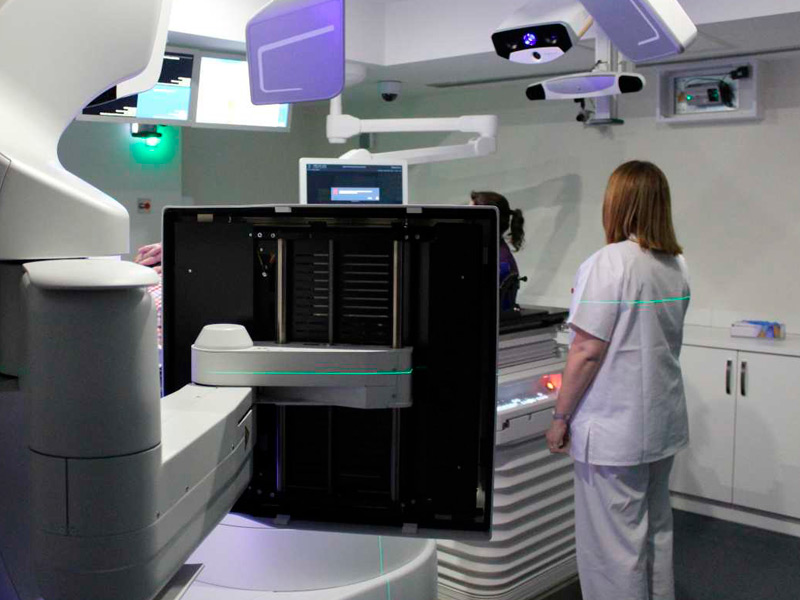
¿Qué se siente durante y después del procedimiento?
La toma de imágenes realizada antes de o durante las sesiones de radioterapia es indolora. Durante la sesión de radioterapia, es posible que usted vea u oiga el equipo moviéndose a su alrededor durante el procedimiento de toma de imágenes. Los pacientes a veces notan un olor extraño causado por el ozono producido por el acelerador lineal. Algunos pacientes también pueden ver una luz a colores cuando reciben su tratamiento; este evento es especialmente cierto para los pacientes que reciben tratamiento del cerebro. Los efectos secundarios de la radioterapia incluyen problemas que ocurren como resultado del tratamiento mismo así como del daño hecho por el tratamiento a las células sanas en el área del tratamiento. El número y la severidad de los efectos secundarios que usted experimenta dependen del tipo de radiación y la dosificación que recibe y la parte del cuerpo sometiéndose a tratamiento. Debe hablar con el medico y la enfermera acerca de cualesquiera efectos secundarios que experimenta para que puedan ayudarle a controlarlos. La radioterapia puede causar efectos secundarios tempraneros y retardados. Los efectos secundarios tempraneros ocurren durante o inmediatamente después del tratamiento y normalmente desaparecen dentro de pocas semanas. Los efectos secundarios tempraneros comunes de la radioterapia incluyen cansancio o fatiga y problemas en la piel. La piel en el área de tratamiento puede ponerse más sensible, roja, irritada o hinchada. Otros cambios en la piel incluyen sequedad, picazón, exfoliación y formación de ampollas.
Según el área sometiéndose a tratamiento, otros efectos secundarios tempraneros pueden incluir: pérdida de pelo en el área de tratamiento problemas en la boca y dificultad en tragar problemas en comer y en la digestión diarrea nausea y vómito dolores de cabeza sensibilidad e hinchazón en el área del tratamiento cambios urinarios y en la vejiga Los efectos secundarios retardados, que son raros, ocurren meses o años después del tratamiento y a menudo son permanentes. Incluyen: cambios cerebrales cambios en la columna vertebral cambios pulmonares cambios hepáticos cambios en el colon y el recto infertilidad cambios en las coyunturas linfedema cambios en la boca cáncer secundario Existe un pequeño riesgo de desarrollar cáncer a causa de la radioterapia. Después de radioterapia para cáncer, usted debe someterse a un examen regular por su radioncólogo para detectar cánceres recurrentes y nuevos. Usando técnicas tales como IGRT, los especialistas en la toma de imágenes están maximizando las capacidades de la radioterapia para destruir el cáncer, y a la vez minimizando su efecto en los tejidos y órganos sanos y los efectos secundarios del tratamiento mismo


